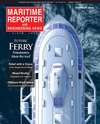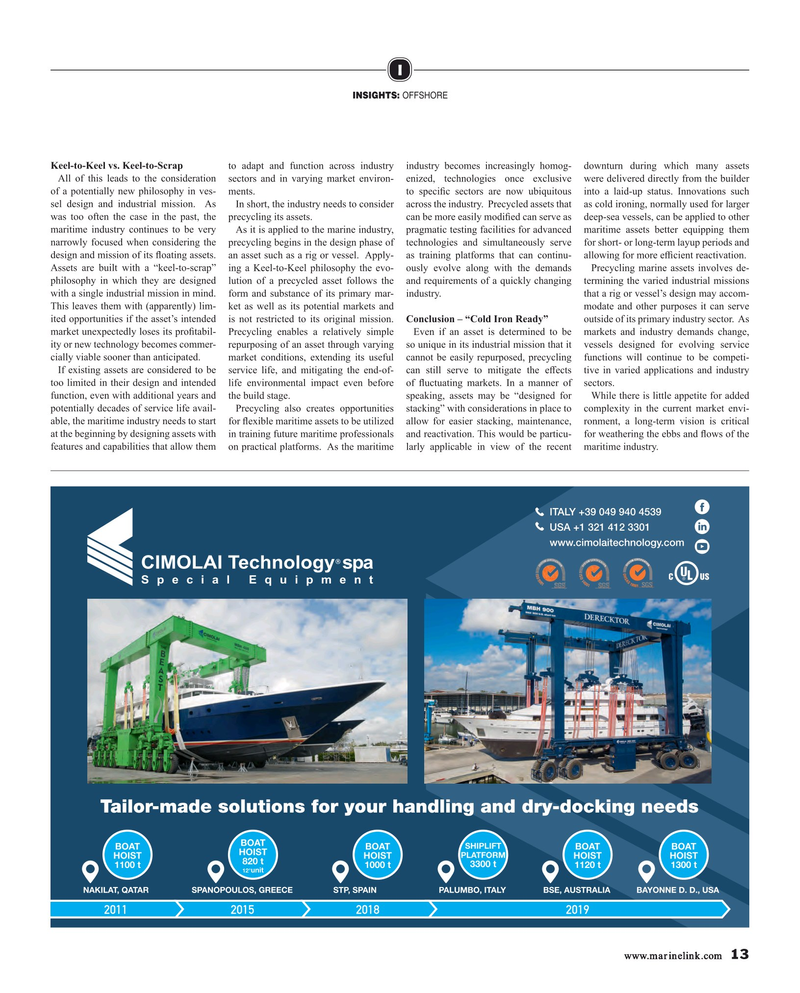
Page 13: of Maritime Reporter Magazine (February 2019)
Ferry Builders
Read this page in Pdf, Flash or Html5 edition of February 2019 Maritime Reporter Magazine
I
INSIGHTS: OFFSHORE
Keel-to-Keel vs. Keel-to-Scrap to adapt and function across industry industry becomes increasingly homog- downturn during which many assets
All of this leads to the consideration sectors and in varying market environ- enized, technologies once exclusive were delivered directly from the builder of a potentially new philosophy in ves- ments. to specifc sectors are now ubiquitous into a laid-up status. Innovations such sel design and industrial mission. As In short, the industry needs to consider across the industry. Precycled assets that as cold ironing, normally used for larger was too often the case in the past, the precycling its assets. can be more easily modifed can serve as deep-sea vessels, can be applied to other maritime industry continues to be very As it is applied to the marine industry, pragmatic testing facilities for advanced maritime assets better equipping them narrowly focused when considering the precycling begins in the design phase of technologies and simultaneously serve for short- or long-term layup periods and design and mission of its foating assets. an asset such as a rig or vessel. Apply- as training platforms that can continu- allowing for more efcient reactivation.
Assets are built with a “keel-to-scrap” ing a keel-to-keel philosophy the evo- ously evolve along with the demands Precycling marine assets involves de- philosophy in which they are designed lution of a precycled asset follows the and requirements of a quickly changing termining the varied industrial missions with a single industrial mission in mind. form and substance of its primary mar- industry. that a rig or vessel’s design may accom-
This leaves them with (apparently) lim- ket as well as its potential markets and modate and other purposes it can serve ited opportunities if the asset’s intended is not restricted to its original mission. Conclusion – “Cold Iron Ready” outside of its primary industry sector. As market unexpectedly loses its proftabil- Precycling enables a relatively simple Even if an asset is determined to be markets and industry demands change, ity or new technology becomes commer- repurposing of an asset through varying so unique in its industrial mission that it vessels designed for evolving service cially viable sooner than anticipated. market conditions, extending its useful cannot be easily repurposed, precycling functions will continue to be competi-
If existing assets are considered to be service life, and mitigating the end-of- can still serve to mitigate the efects tive in varied applications and industry too limited in their design and intended life environmental impact even before of fuctuating markets. In a manner of sectors. function, even with additional years and the build stage. speaking, assets may be “designed for While there is little appetite for added potentially decades of service life avail- Precycling also creates opportunities stacking” with considerations in place to complexity in the current market envi- able, the maritime industry needs to start for fexible maritime assets to be utilized allow for easier stacking, maintenance, ronment, a long-term vision is critical at the beginning by designing assets with in training future maritime professionals and reactivation. This would be particu- for weathering the ebbs and fows of the features and capabilities that allow them on practical platforms. As the maritime larly applicable in view of the recent maritime industry.
ITALY +39 049 940 4539
USA +1 321 412 3301 www.cimolaitechnology.com
Tailor-made solutions for your handling and dry-docking needs
BOAT
SHIPLIFT
BOAT BOAT BOAT BOAT
HOIST
PLATFORM
HOIST HOIST HOIST HOIST 820 t 1100 t 1000 t 3300 t 1120 t 1300 t 12°unit
SPANOPOULOS, GREECE NAKILAT, QATAR STP, SPAIN PALUMBO, ITALYBSE, AUSTRALIABAYONNE D. D., USA 2011 2015 2018 2019 www.marinelink.com 13

 12
12

 14
14
